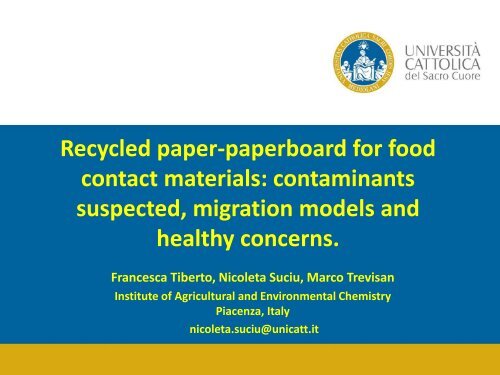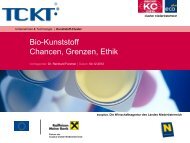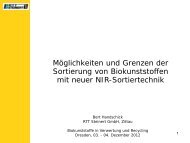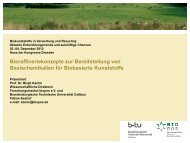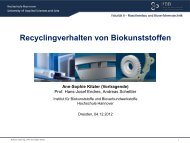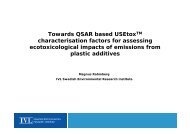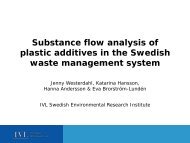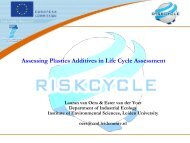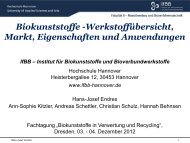Recycled paper-paperboard for food contact materials ...
Recycled paper-paperboard for food contact materials ...
Recycled paper-paperboard for food contact materials ...
You also want an ePaper? Increase the reach of your titles
YUMPU automatically turns print PDFs into web optimized ePapers that Google loves.
<strong>Recycled</strong> <strong>paper</strong>-<strong>paper</strong>board <strong>for</strong> <strong>food</strong><br />
<strong>contact</strong> <strong>materials</strong>: contaminants<br />
suspected, migration models and<br />
healthy concerns.<br />
Francesca Tiberto, Nicoleta Suciu, Marco Trevisan<br />
Institute of Agricultural and Environmental Chemistry<br />
Piacenza, Italy<br />
nicoleta.suciu@unicatt.it
Summary<br />
Introduction<br />
Objectives<br />
First part: determination of the contaminants<br />
Second part: migration tests<br />
Conclusions
Introduction<br />
Food packaging is the most common way to:<br />
- store <strong>food</strong>s at different environmental conditions;<br />
- extend the shelf-life of the products;<br />
- safeguard <strong>food</strong>s from natural agents;<br />
- protect <strong>food</strong>s from any type of external pollution.<br />
packaging is necessary to preserve the quality and the safety of the <strong>food</strong>s.<br />
In some cases packaging can become a new source of contaminants that<br />
can affect the organoleptic properties of the <strong>food</strong>s and make them<br />
hazardous to the <strong>food</strong> consumers.<br />
it is necessary to control the composition of the packaging and<br />
assess the potential migrations of the compounds to the <strong>food</strong>s.
Food <strong>contact</strong> <strong>materials</strong>:<br />
why recycled <strong>paper</strong>-<strong>paper</strong>board<br />
‣ A way to minimize the amount of worldwide wastes, preserve natural resources.<br />
‣ In Europe about half of the <strong>paper</strong>/board production is directly/indirectly concerned by<br />
<strong>food</strong>-<strong>contact</strong> <strong>materials</strong>.<br />
‣ They are usually perceived by consumers as safe/healthy due to the natural origin of<br />
the wood.<br />
‣ Unintentionally added compounds due to the incorporation of recycled pulp, additives<br />
used to make recycled <strong>materials</strong> suitable <strong>for</strong> <strong>food</strong> packaging must be considered as<br />
potential hazardous migrants.<br />
‣ Lack of specific laws: necessary an approach like plastic <strong>food</strong>-<strong>contact</strong> <strong>materials</strong><br />
‣ Reg. (UE) N. 1935/2004 only affirms that recycled <strong>paper</strong> can just be used <strong>for</strong> solid dry<br />
<strong>food</strong>s (salt, sugar, pasta, rice, flour,…).<br />
an increasing lobby which recommends the «not use» of waste <strong>paper</strong><br />
packaging <strong>for</strong> <strong>food</strong> <strong>contact</strong> applications.<br />
1<br />
Reg. (UE) N. 10/2011, Reg. PIM (Plastic Implementation Measure)
Contaminants investigated (1)<br />
Bisphenol A, BPA<br />
polycarbonate plastics, epoxy resins<br />
<strong>for</strong> cans, microwave containers,<br />
baby’s bottles, …<br />
founded in wastewaters from waste<strong>paper</strong> recycling plants<br />
contaminant in recycled fibers<br />
Biochemical changes in brain, immune-modulatory effects, enhance<br />
susceptibility to breast tumours<br />
TDI of 0.05 mg/kg b.w./day – NOAEL 5 mg/kg b.w./day (uncertainty<br />
factor: 100) 2<br />
2<br />
EFSA, 2010.
Contaminants investigated (2)<br />
Bis(2-ethylhexyl)phthalate, DEHP<br />
Since 1930 industrial success as additive to<br />
PVC to increase flexibility<br />
Exponential<br />
applicability<br />
adhesives, lacquers, waxes, inks, cosmetics, insecticides,…<br />
present in <strong>paper</strong>-<strong>paper</strong>board <strong>food</strong> packaging:<br />
contamination of raw <strong>materials</strong> and/or process<br />
Endocrine disruption properties, reducing man fertility<br />
TDI of 0.05 mg/kg bw/day - NOAEL of 5 mg/kg bw/day (uncertainty factor:<br />
100) 3<br />
3<br />
EFSA, 2010.
Contaminants investigated (3)<br />
Nonylphenol monoethoxylate, NMP - Nonylphenol diethoxylate, NDP<br />
Environmental ubiquitous contaminants (aquatic systems): contamination of raw<br />
<strong>materials</strong><br />
in lubricants, detergents, resins, plasticizers, herbicides, cosmetics,…<br />
used as dispersing/stabilizing agents in <strong>paper</strong> <strong>food</strong> packaging process<br />
oestrogenic activity - endocrine disrupting effects in vitro/in vivo experiments<br />
activity on the reproductive system /carcinogenics
Objectives<br />
Assess real degree of suitability of some recycled <strong>paper</strong>-<strong>paper</strong>board<br />
packaging available on the market.<br />
The experimental study was divided into 2 sequent parts:<br />
1. determination of contaminants concentrations in recycled <strong>paper</strong>-<strong>paper</strong>board<br />
samples;<br />
2. carrying out migration tests of the identified contaminants in a <strong>food</strong> (NaCl) and<br />
in a <strong>food</strong> simulant (Tenax).<br />
The first part was conducted to know the real composition of the samples about<br />
the contaminants – they can derive from raw <strong>materials</strong>, manufacturing process<br />
and environment.<br />
The second part had the aim of estimate the potential transfer of the<br />
contaminants investigated in the first part, considering different conservation’s<br />
conditions.
First part:<br />
<strong>materials</strong> and methods (1)<br />
Solvents and reagents<br />
BPA: methanol (0,06-25 mg L -1 )<br />
DEHP: hexane (0,5-60 mg L -1 )<br />
NMP, NDP: hexane (0,1-10 mg L -1 )<br />
STANDARD SOLUTIONS<br />
Extraction method<br />
Extraction in triplicate<br />
• Removal outside printed surface cut into small pieces (ca. 0,5x1 cm)<br />
• Soxhlet extraction (with anhydrous sulfate)<br />
- BPA: ethanol, 15 cycles, 2,5 g <strong>paper</strong> material<br />
- DEHP, NMP, NDP: hexane:acetone (4:1), 6 hours, 1 g <strong>paper</strong> material<br />
• Rotavapor 10 ml hexane evaporation under N 2 stream 1 ml I.S.<br />
Internal standards (I.S.): anthracene-d 10 , perylene-d 12 (1 mg L -1 )
First part:<br />
<strong>materials</strong> and methods (2)<br />
GC-MS analysis<br />
‣ Agilent Technologies gas chromatograph 6890 series<br />
‣ Supelco SLB-5ms type column<br />
‣ high grade helium - carrier gas<br />
GC-MS analyses<br />
in triplicate<br />
• Identification of contaminants: TOTAL ION MONITORING MODE<br />
• Quantification of contaminants (except DEHP): SELECTED ION MONITORING<br />
MODE (SIM)<br />
• Final measurements using internal standards calibration curves
First part:<br />
<strong>paper</strong> and <strong>paper</strong>board samples<br />
Sample<br />
no.<br />
Product Contact Type of <strong>paper</strong> Percentage of recycled<br />
material<br />
91 Cereals Barley box Indirect Direct <strong>Recycled</strong> n.s. 100% n.s.<br />
10 2 Pasta Eggs box Direct <strong>Recycled</strong> ca. 100% 40%<br />
11 3 Rice-pasta Salt box Direct n.s. n.s.<br />
box<br />
12<br />
4 Sugar<br />
Rice box<br />
box<br />
Indirect<br />
Direct<br />
<strong>Recycled</strong><br />
n.s.<br />
100%<br />
n.s.<br />
13<br />
5<br />
Napkins<br />
Take-away<br />
-<br />
Direct<br />
<strong>Recycled</strong><br />
n.s.<br />
100%<br />
n.s.<br />
14<br />
pizza box 1<br />
Polenta Indirect <strong>Recycled</strong> 80-90%<br />
15 Take- away<br />
6 Frozen pizza box pizza 2<br />
box 1<br />
Direct n.s. n.s.<br />
Indirect <strong>Recycled</strong> ca. 90%<br />
16 7 Frozen Soy box pizza Indirect Direct <strong>Recycled</strong> n.s. ca. n.s. 90%<br />
box 2<br />
8 Lentils box Direct n.s. n.s.<br />
17 Salt box 2 Direct n.s. n.s.<br />
n.s. Not specified.
First part:<br />
results<br />
Sample no.<br />
DEHP<br />
(mg Kg -1 )<br />
NMP<br />
(mg Kg 1 )<br />
NDP<br />
(mg Kg -1 )<br />
1 11.66±0.45 0.23±0.01 0.61±0.05<br />
2 2.42±0.20 x 0.46±0.08<br />
3 9.68±1.22 0.10±0.01 0.38±0.02<br />
4 75.23±18.65 0.33±0.06 0.54±0.07<br />
5
First part:<br />
discussion<br />
Not all samples contain the selected contaminants<br />
‣ DEHP was detected in twelve samples: except sample no. 4 and no. 16, all <strong>paper</strong><br />
<strong>materials</strong> show DEHP concentrations range from 1.10 and 16.27 mg Kg -1<br />
concentrations detected with the method presented confirm the results of the<br />
literature.<br />
‣ NMP was founded in thirteen samples and quantified in eight, NDP was detected in all<br />
tested samples and quantified in all samples, except no. 9.<br />
detected levels are slightly higher than literature values - considering the virgin<br />
nature of the samples investigated.
Second part:<br />
migration tests<br />
Materials<br />
FOOD: NaCl<br />
SIMULANT: Tenax TA 60-80 mesh (modified polyphenylene oxide, MPPO)<br />
PAPER SAMPLE: no. 1 (Cereal box)<br />
TARGET CONTAMINATS: DEHP, NMP, NDP<br />
Test design<br />
Paperboard exposed to matrix in glass dishes (basal area 0.25 dm 2 ) wrapped in<br />
aluminum foil<br />
Test conditions Contact matrix g/dm 2<br />
10 days (20±2)°C NaCl 10/0.25<br />
10 days 40°C Tenax 1/0.25
Second part:<br />
extraction method<br />
• Twice solid-liquid extraction under agitation, at environmental temperature<br />
filtration<br />
NaCl: methanol<br />
TENAX: hexane<br />
Extraction and recovery<br />
in triplicate<br />
• Rotavapor 10 ml hexane evaporation under N 2 stream 1 ml I.S. 2<br />
Contaminant NaCl recovery (%) Tenax recovery (%)<br />
DEHP 79±10 103±19<br />
NMP 106±8 120±16<br />
NDP 104±11 125±19<br />
2<br />
Internal Standards
Second part:<br />
results<br />
Contaminant<br />
Paper<br />
concentration<br />
(μg dm 2 )<br />
Migration<br />
(μg dm 2 )<br />
DEHP 46.64 ± 1.80 0.64 ± 0.52<br />
NMP 0.92 ± 0.04 nm<br />
NDP 2.44 ± 0.20 nm<br />
Contaminant<br />
Paper<br />
concentration<br />
(μg dm 2 )<br />
Migration<br />
(μg dm 2 )<br />
DEHP 46.64 ± 1.80 5.04 ± 1.48<br />
NMP 0.92 ± 0.04 0.68 ± 0.24<br />
NDP 2.44 ± 0.20 1.8 ± 1.28<br />
NaCl<br />
TENAX<br />
nm: not significant migration
Second part:<br />
discussion<br />
Contaminant % Migration NaCl % Migration Tenax<br />
DEHP 1 11<br />
NMP nm 72<br />
NDP nm 74<br />
MIGRATION IN TENAX > MIGRATION IN NaCl<br />
nm: not significant migration<br />
Consider much more long time of <strong>contact</strong> matrix - <strong>paper</strong> <strong>for</strong> migration in NaCl<br />
due to its shelf-life<br />
migration tests will be continue considering 1, 2 and 3 months to assess<br />
transfer of contaminats under conditions much similar to the reality
Conclusions (1)<br />
A procedure <strong>for</strong> analysing four chemical contaminants in recycled <strong>paper</strong>-<strong>paper</strong>board<br />
<strong>materials</strong> has been developed<br />
applicability of the method was illustrated using commercial products<br />
selected contaminants are generally present in the tested samples at levels in agreement<br />
with the literature<br />
recycled fibers have a great influence on the amount of chemicals<br />
present in the end-products.<br />
a migration’s study was introduced: comparison of migration behaviors of contaminants<br />
after 10 days of <strong>contact</strong> with NaCl and Tenax<br />
much more migration in Tenax due to its high absorbent power<br />
results obtained confirm literature levels<br />
THE WORK IS COMING ALONG WITH THE COMPLETION OF MIGRATION STUDIES<br />
Paperboard detection and migration tests <strong>for</strong> BPA<br />
Migration tests <strong>for</strong> long time
Conclusions (2)<br />
The results of the study suggests that it is recommendable a higher<br />
care <strong>for</strong> the use of recycling <strong>paper</strong>-<strong>paper</strong>board as <strong>food</strong> packaging.<br />
RECYCLED<br />
FRESH<br />
NON FOOD<br />
COSMETICS -<br />
PHARMACEUTICALS<br />
DRINKS<br />
PAPER-BASED<br />
PACKAGING<br />
DESTINATION<br />
FOOD<br />
WHY DON’T FOCUS MORE - EVEN ALL- RECYCLED<br />
PAPER-PAPERBOARD TO NON-FOOD SECTORS
Thank you <strong>for</strong> your<br />
attention!<br />
Thank you <strong>for</strong> your attention!


